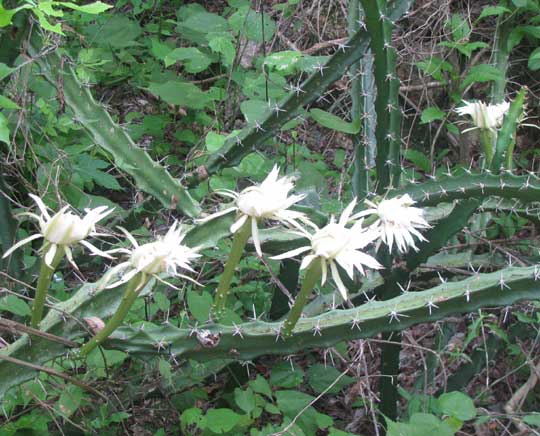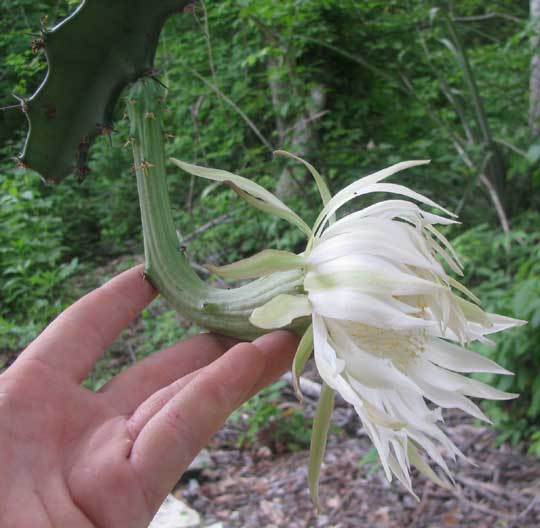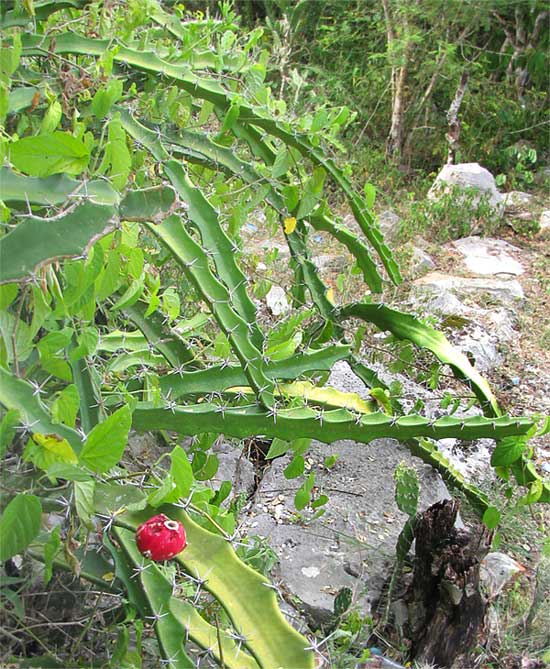Excerpts from Jim Conrad's
Naturalist Newsletter
from the June 13, 2010 Newsletter issued from Hacienda Chichen Resort beside Chichén Itzá Ruins, central Yucatán, MÉXICO; limestone bedrock, elevation ~39m (~128ft), ~N20.676°, ~W88.569°
ACANTHOCEREUS CACTUS FLOWERING
At dusk the other day I was about to call it a day when I looked across the gravel trail running before my hut and saw that the Acanthocereus cacti were just loaded with opening flowers. Until then I'd not noticed flower-bud formation and growth, so that must have taken place very fast. You can see how the large, white flowers glow in dusk's dim light below:

A picture the next morning, after they'd flowered all night, showing the ovary and flowers -- the flowers about seven inches in diameter (18 cm) -- is shown below:

This is one of several species often known as Night-blooming Cereus; it's ACANTHOCEREUS TETRAGONUS. In this area we have two common species likely to be called Night-blooming Cereuses, though the species belong to two entirely different genera. The one in the picture, Acanthocereus, grows on the ground while the other, discussed below, is epiphytic on trees.
All the ones here in my general area bloomed on the same night and by the next afternoon the flowers had been reduced to droopy, brown messes. I can't find mention on the Internet of such synchronous flowering, so maybe all the plants in my area drive from the same clone, or maybe it was just a coincidence. To be honest, it was too hot to go make a real study of the issue.
I read that the flowers are pollinated by nocturnal hummingbird moths.
from the August 25, 2008 Newsletter issued from near Sabacché, Yucatán, MÉXICO
ACANTHOCEREUS CACTI FRUITING
These trails through the scrub nearly always are bordered by walls up to chest high and built of white, irregular-shaped, uncemented limestone rocks. One of the most typical sights along these walls is a certain much-branched, somewhat sprawling cactus clambering over the walls' top, as shown below:

That's ACANTHOCEREUS TETRAGONUS, for which I can't find a common English name. Folks here of course have a Maya name but it's hard for me to guess how it'd be printed. My best guess is X'nuun Tsutsuy (shnoon tsoot-SOO-ee).
As in the picture, often this cactus bears a single, red, jumbo-egg-size fruit, but so far I haven't found a single fruit that hasn't been opened by animals and emptied. The fruit in the picture has a quarter-size hole on its far side and the red part is nothing but a dry shell.
"It's sweet and good eating, but full of seeds," I'm told. "The problem is finding find one the birds haven't gotten to first."
The cactus is also appreciated for its medicinal value. If you get cut, you can slice off a slab of stem, apply the slab's succulent, mucilaginous face to the cut, and it'll prevent infection.